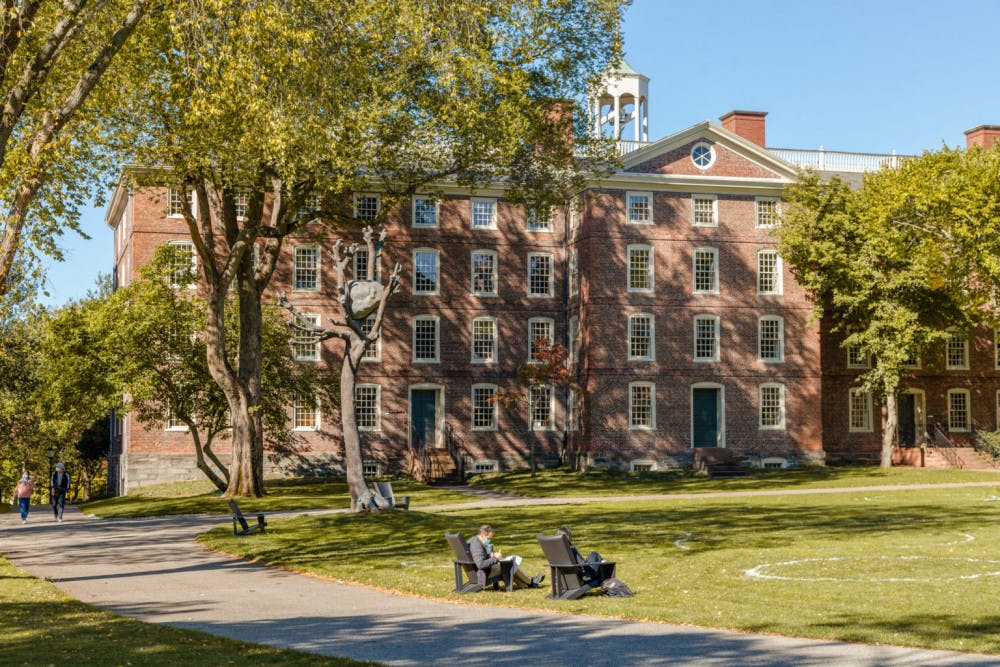Members of the University’s administration and student body discussed changes for the upcoming summer and fall semesters, updates on the Food Access Initiative and the progress of the Brook Street dormitory project at the Brown University Community Council’s final meeting of the semester Wednesday.
Summer semester
President Christina Paxson P’19 opened the meeting with a discussion of the University’s first summer semester with full course offerings in years, which will take place from May 12 to Aug. 13. The semester will mainly involve first-year students, some sophomores and students working in labs and doing research.
Paxson emphasized the University’s commitment to making the semester feel as close as possible to normal summer operations for staff, announcing that staff will be on summer hours from June 1 to Aug. 13.
“The staff at Brown have been working so hard this year, and it's felt for many people just nonstop from last March through the anniversary of the pandemic,” Paxson said. “We recognize and we appreciate everything that the employees are doing.”
Paxson also announced that Employee Appreciation Day will take place on May 7 this year, hopefully giving staff a chance to “step back and recharge a little bit.”
Fall semester and vaccines
Paxson then moved on to a discussion of the fall 2021 semester, which she envisions as much closer to the University’s pre-pandemic operations. This will include a two-semester academic calendar, all students residing on campus and normal room occupancy. Paxson placed a special emphasis on returning to normal University athletics as well as standard lab and research operations. Remote access to University academics and resources will still be given to those who need it, she added.
The University has also launched a committee to give recommendations on handling remote and hybrid operations in the fall for students who cannot return to campus. The committee plans to share a report June 1.
Paxson emphasized that the only way for the University to return to normalcy is through “very high vaccination rates within the Brown community.” She encouraged all members of the Brown community to get the vaccines when they become eligible, as the University will require all students except those with medical and religious exemptions to be vaccinated to return to campus in the fall.
The University is also working on making vaccines available for international students upon their return to campus, though establishing a vaccination site on campus has not yet been authorized by the state. A group is handling how the University will accommodate students who received vaccines internationally that have yet to be approved by the Food and Drug Administration.
Though booster shots may be required for the vaccines about five months after the initial vaccination, these booster shots should not pose an issue to the University’s dedication to a return to normalcy, said Russell Carey ’91 MA’06, executive vice president for planning and policy. “We are paying close attention to that, and I think we can adjust accordingly over the next several months as we need to.”
GSC Produce Initiative
Kathryn Thompson GS, president of the Graduate Student Council, discussed updates on the GSC Produce Initiative, also known as the Food Access Initiative. The initiative works alongside the Office of the President and Dining Services to provide weekly access to fresh produce to graduate students who struggle with food insecurity.
Food insecurity is the “limited or uncertain availability of different nutritional or adequate safe foods for individuals or the ability to acquire those foods in a socially acceptable manner, … from worrying about the ability to obtain food to experiencing hunger,” Thompson said. Within the Brown community, food insecurity disproportionately affects students of color and has been exacerbated by the pandemic, she added.
For graduate students working to support themselves and their families, food insecurity affects both academic productivity and physical and mental health, Thompson said. Those on a budget frequently cut out produce from their groceries first, she added, making healthier lifestyles more difficult to maintain.
The initiative launched March 24 and currently supports about 90 students weekly. Thompson hopes it will continue into the fall semester. The program has also received authorization to hire a graduate student employee, and the selection process for that individual is underway.
Brook Street dorm
Craig Barton ’78, University architect and professor of the practice of history of art and architecture, gave an update on the Brook Street dormitory project. The project will build two five-story residential buildings on Brook Street in an attempt to provide more “on-campus housing options for juniors and seniors.”
The dormitory will be made up of suites of two to four single rooms, and the suites will be joined by common kitchens. “The organization of public and private spaces is going to make for a really rich and vibrant community,” Barton said.
The project was initially reviewed by the Providence City Planning Commission, and after the University amended the plan, was approved in June 2020. Construction on the project was delayed due to the COVID-19 pandemic. Since then, project leaders have met with local groups, including the Providence Historic District Commission, to hear about community concerns over the building, including its scale, density, size and the possibility of increased traffic due to potential reintroduction of retail on the block.
“Good projects are made by rethinking the project at the appropriate moments, and we did that here,” Barton said. “We heard the community’s concerns and made some significant adjustments to the project.”
The University has revised its plans for the dorm, reducing the square footage of the buildings, which will now be capable of housing 350 students rather than the original 375, The Herald previously reported. There was also a shift in focus to the development of publicly accessible green spaces in the area and common creative and rehearsal spaces on the ground floor of the buildings. The project will also work within the University’s sustainability goals.
Final remarks on inclusion
With the Health and Wellness Center and Residence Hall opening up this summer, the University hopes to achieve its longtime goal of ensuring on-campus undergraduate housing for six semesters, Paxson added.
Paxson also mentioned the University’s move into Phase II of the Diversity and Inclusion Action Plan. “We realize that the work is not over,” Paxson said. “Phase II is about reflecting on the best tactics and strategies for achieving the goals that we set for ourselves in 2016.”
She concluded the meeting with a mention of the search for the new Department of Public Safety chief. In light of recent events, Paxson wants “to make Brown a model for a place where all members of our community feel secure on campus and feel safe when they're here,” she said. “That's just my promise to you.”

Alex Nadirashvili was the managing editor of multimedia and social media for The Brown Daily Herald's 133rd Editorial Board. As a former University News editor, he covered faculty, higher education and student life, though his proudest legacy is The Brown Daily Herald TikTok account.





